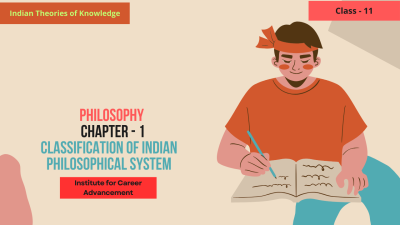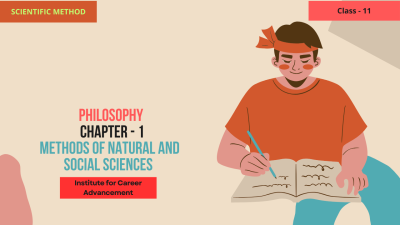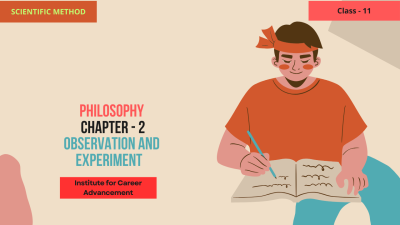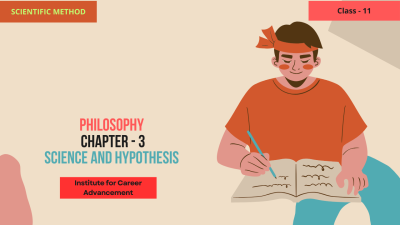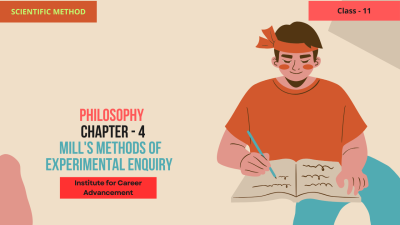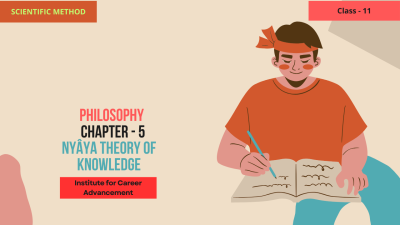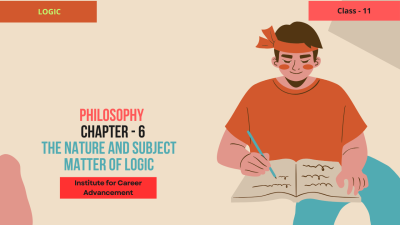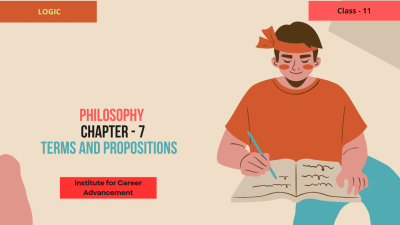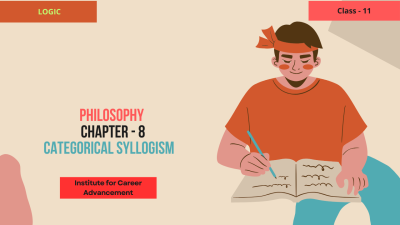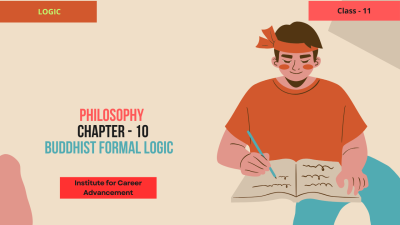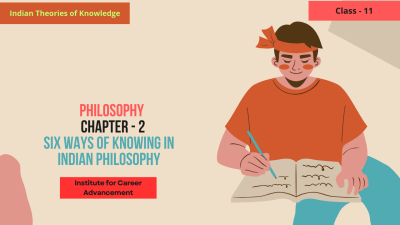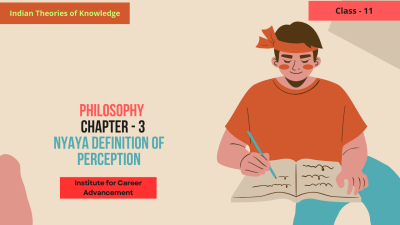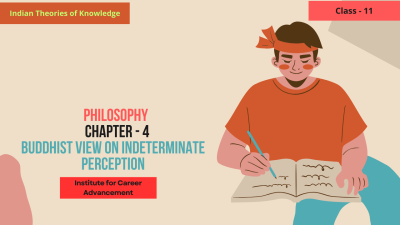Course description
The Indian Philosophical System is a significant component of the Class 11 Philosophy curriculum in India. The course aims to introduce students to the various philosophical schools of thought that emerged in India. These schools address questions about the nature of reality, the self, knowledge, and ethics. The classification of Indian philosophical systems is traditionally divided into two main categories:
1. Āstika (Orthodox) Systems
These schools accept the authority of the Vedas and are considered orthodox or traditional. There are six classical schools of Indian philosophy that fall under the Āstika category:
Nyāya (Logic and Epistemology)
Founded by Gautama (also known as Akṣapāda).
Focuses on logical reasoning, epistemology (the study of knowledge), and debate.
Teaches that valid knowledge can be attained through perception, inference, comparison, and testimony.
Vaiśeṣika (Atomism)
Founded by Kanada.
This school discusses the nature of reality, focusing on categories like substance, quality, action, generality, particularity, and inherence.
Vaiśeṣika theory posits that the universe consists of atomic particles and atoms.
Sāṅkhya (Enumeration)
Founded by Kapila.
A dualistic system that explains the relationship between Purusha (consciousness) and Prakriti (nature or material world).
Emphasizes the concept of liberation (moksha) by understanding the distinction between the self and the material world.
Yoga (Union)
Associated with Patanjali's Yoga Sutras.
A system of physical and mental discipline aimed at achieving spiritual liberation (moksha) through meditation, concentration, and ethical practices.
Yoga is closely tied to the Sāṅkhya philosophy but focuses more on practical methods for achieving control over the mind.
Mīmāṁsā (Exegesis)
Founded by Jaimini.
This school emphasizes the study of the Vedas, particularly the rituals and dharma (moral duties).
Focuses on how to interpret and perform Vedic rituals correctly to achieve spiritual merit.
Vedānta (End of the Vedas)
Based on the teachings of the Upanishads and the Brahma Sutras.
Prominent philosophers include Adi Shankaracharya, Ramanuja, and Madhva.
Explores the nature of reality, the self, and the ultimate truth (Brahman).
The major schools are Advaita Vedanta (non-dualism), Vishishtadvaita Vedanta (qualified non-dualism), and Dvaita Vedanta (dualism).
2. Nāstika (Heterodox) Systems
These systems do not accept the authority of the Vedas and are considered non-orthodox. The main Nāstika schools include:
Buddhism
Founded by Gautama Buddha.
Denies the existence of a permanent self (atman) and emphasizes the Four Noble Truths and the Eightfold Path as a way to achieve enlightenment and liberation (nirvana).
Focuses on ethical conduct, mental discipline, and wisdom.
Jainism
Founded by Mahavira.
Advocates for the doctrine of ahimsa (non-violence) and teaches that the soul can attain liberation (moksha) through right knowledge, right faith, and right conduct.
Focuses on ascetic practices and spiritual discipline.
Cārvāka (Materialism)
A materialist and atheist school of thought.
Denies the existence of the afterlife or divine entities.
Emphasizes the pursuit of pleasure and living in the present, focusing on the material world and sensory experience.
Key Concepts in Indian Philosophy:
Dharma: Righteousness, moral duties, and the path to spiritual progress.
Karma: The principle of cause and effect, where one's actions determine future outcomes.
Moksha: Liberation from the cycle of birth and rebirth (samsara).
Atman: The self or soul, which is considered eternal.
Brahman: The ultimate reality or cosmic principle in Vedanta philosophy.
This classification provides a structured approach to understanding the diverse philosophical traditions of India, from the logical and metaphysical to the ethical and spiritual. The Class 11 course prepares students to engage critically with these ideas and understand their relevance in both historical and contemporary contexts.
ভারতীয় দার্শনিক ব্যবস্থা ভারতের একাদশ শ্রেণির দর্শন পাঠ্যক্রমের একটি গুরুত্বপূর্ণ উপাদান। এই কোর্সের লক্ষ্য হল ভারতে উদ্ভূত বিভিন্ন দার্শনিক চিন্তাধারার সঙ্গে শিক্ষার্থীদের পরিচয় করিয়ে দেওয়া। এই বিদ্যালয়গুলি বাস্তবতার প্রকৃতি, স্ব, জ্ঞান এবং নৈতিকতা সম্পর্কে প্রশ্নগুলির সমাধান করে। ভারতীয় দার্শনিক ব্যবস্থার শ্রেণিবিন্যাস ঐতিহ্যগতভাবে দুটি প্রধান বিভাগে বিভক্তঃ 1টি। আস্তিকা (অর্থোডক্স) সিস্টেম এই বিদ্যালয়গুলি বেদের কর্তৃত্বকে গ্রহণ করে এবং এগুলি গোঁড়া বা ঐতিহ্যবাহী হিসাবে বিবেচিত হয়। ভারতীয় দর্শনের ছয়টি ধ্রুপদী বিদ্যালয় রয়েছে যা আস্তিক বিভাগের অধীনে পড়েঃ ন্যায় (যুক্তি ও জ্ঞানতত্ত্ব) গৌতম দ্বারা প্রতিষ্ঠিত (যিনি অক্ষপদ নামেও পরিচিত) যৌক্তিক যুক্তি, জ্ঞানতত্ত্ব (জ্ঞান অধ্যয়ন) এবং বিতর্কের উপর দৃষ্টি নিবদ্ধ করে। শিক্ষা দেয় যে উপলব্ধি, অনুমান, তুলনা এবং সাক্ষ্যের মাধ্যমে বৈধ জ্ঞান অর্জন করা যেতে পারে। বৈশেষিক (পরমাণুবাদ) কানাডা দ্বারা প্রতিষ্ঠিত। এই বিদ্যালয়টি বাস্তবতার প্রকৃতি নিয়ে আলোচনা করে, বস্তু, গুণমান, কর্ম, সাধারণতা, বিশেষত্ব এবং আনুগত্যের মতো বিভাগগুলিতে মনোনিবেশ করে। বৈশেষিক তত্ত্ব বলে যে মহাবিশ্ব পারমাণবিক কণা এবং পরমাণু নিয়ে গঠিত। সাংখ্য (গণনা) কপিলা দ্বারা প্রতিষ্ঠিত। একটি দ্বৈতবাদী ব্যবস্থা যা পুরুষ (চেতনা) এবং প্রকৃতি (প্রকৃতি বা বস্তুগত জগত) এর মধ্যে সম্পর্ক ব্যাখ্যা করে আত্ম এবং বস্তুগত জগতের মধ্যে পার্থক্য বোঝার মাধ্যমে মুক্তির (মোক্ষ) ধারণার উপর জোর দেয়। যোগ (ইউনিয়ন) পতঞ্জলির যোগ সূত্রের সঙ্গে যুক্ত। ধ্যান, একাগ্রতা এবং নৈতিক অনুশীলনের মাধ্যমে আধ্যাত্মিক মুক্তি (মোক্ষ) অর্জনের লক্ষ্যে শারীরিক ও মানসিক শৃঙ্খলার একটি ব্যবস্থা। যোগ সাংখ্য দর্শনের সাথে ঘনিষ্ঠভাবে জড়িত তবে মনের উপর নিয়ন্ত্রণ অর্জনের জন্য ব্যবহারিক পদ্ধতির উপর আরও বেশি মনোনিবেশ করে। মীমাংসা (ব্যাখ্যা) প্রতিষ্ঠা করেন জয়মিনি। এই বিদ্যালয়টি বেদ অধ্যয়নের উপর জোর দেয়, বিশেষ করে আচার-অনুষ্ঠান এবং ধর্মের (নৈতিক কর্তব্য) উপর। আধ্যাত্মিক যোগ্যতা অর্জনের জন্য কীভাবে বৈদিক আচার-অনুষ্ঠানগুলি সঠিকভাবে ব্যাখ্যা ও সম্পাদন করা যায় সেদিকে মনোনিবেশ করা হয়। বেদান্ত (বেদের সমাপ্তি) উপনিষদ এবং ব্রহ্ম সূত্রের শিক্ষার উপর ভিত্তি করে। বিশিষ্ট দার্শনিকদের মধ্যে রয়েছেন আদি শঙ্করাচার্য, রামানুজ এবং মাধব। বাস্তবতা, স্ব এবং চূড়ান্ত সত্যের প্রকৃতি অন্বেষণ করে (ব্রাহ্মণ) প্রধান বিদ্যালয়গুলি হল অদ্বৈত বেদান্ত (অদ্বৈতবাদ), বিশিষ্টদ্বৈত বেদান্ত (অদ্বৈতবাদ) এবং দ্বৈত বেদান্ত (দ্বৈতবাদ)। 2. নাস্তিক (হেটেরোডক্স) সিস্টেম এই ব্যবস্থাগুলি বেদের কর্তৃত্বকে গ্রহণ করে না এবং এগুলিকে অপ্রচলিত বলে মনে করা হয়। প্রধান নাস্তিক বিদ্যালয়গুলির মধ্যে রয়েছেঃ বৌদ্ধধর্ম গৌতম বুদ্ধ দ্বারা প্রতিষ্ঠিত। একটি স্থায়ী স্ব (আত্মা) এর অস্তিত্বকে অস্বীকার করে এবং জ্ঞান ও মুক্তি (নির্বাণ) অর্জনের উপায় হিসাবে চারটি মহৎ সত্য এবং আটগুণ পথের উপর জোর দেয়। নৈতিক আচরণ, মানসিক শৃঙ্খলা এবং প্রজ্ঞার উপর দৃষ্টি নিবদ্ধ করে। জৈনধর্ম মহাবীর দ্বারা প্রতিষ্ঠিত। অহিংসা (অহিংসা) মতবাদের প্রবক্তা এবং শিক্ষা দেন যে আত্মা সঠিক জ্ঞান, সঠিক বিশ্বাস এবং সঠিক আচরণের মাধ্যমে মুক্তি (মোক্ষ) অর্জন করতে পারে। তপস্বী অনুশীলন এবং আধ্যাত্মিক শৃঙ্খলার উপর দৃষ্টি নিবদ্ধ করে। চার্বাক (বস্তুবাদ) একজন বস্তুবাদী এবং নাস্তিক চিন্তাধারা। পরকাল বা ঐশ্বরিক সত্তার অস্তিত্বকে অস্বীকার করে। বস্তুগত জগৎ এবং সংবেদনশীল অভিজ্ঞতার উপর মনোযোগ কেন্দ্রীভূত করে আনন্দের অন্বেষণ এবং বর্তমানের জীবনযাপনের উপর জোর দেয়। ভারতীয় দর্শনের মূল ধারণাগুলিঃ ধর্মঃ ধার্মিকতা, নৈতিক কর্তব্য এবং আধ্যাত্মিক অগ্রগতির পথ। কর্মঃ কারণ এবং প্রভাবের নীতি, যেখানে একজনের কর্ম ভবিষ্যতের ফলাফল নির্ধারণ করে। মোক্ষঃ জন্ম ও পুনর্জন্মের চক্র থেকে মুক্তি (সংসার) আত্মাঃ আত্ম বা আত্মা, যা চিরন্তন বলে বিবেচিত হয়। ব্রাহ্মণঃ বেদান্ত দর্শনের চূড়ান্ত বাস্তবতা বা মহাজাগতিক নীতি। এই শ্রেণিবিন্যাস যুক্তিসঙ্গত এবং অধিবিদ্যামূলক থেকে নৈতিক এবং আধ্যাত্মিক পর্যন্ত ভারতের বিভিন্ন দার্শনিক ঐতিহ্য বোঝার জন্য একটি কাঠামোগত পদ্ধতি প্রদান করে। একাদশ শ্রেণির কোর্সটি শিক্ষার্থীদের এই ধারণাগুলির সাথে সমালোচনামূলকভাবে জড়িত হতে এবং ঐতিহাসিক ও সমসাময়িক উভয় প্রেক্ষাপটে তাদের প্রাসঙ্গিকতা বুঝতে প্রস্তু

